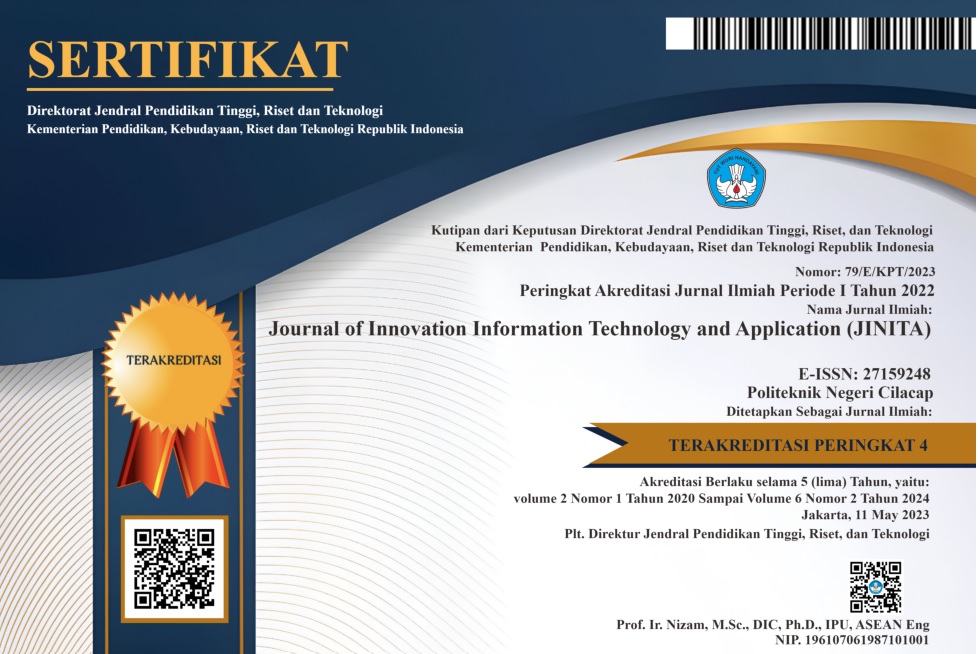Decision Making for The Most Outstanding Students Award using TOPSIS: a Case Study at Institut Teknologi Sumatera
 Abstract views: 140
,
Abstract views: 140
,
 pdf downloads: 171
pdf downloads: 171
Abstract
The internal selection of Pemilihan Mahasiswa Berprestasi, or known as Pilmapres, is an annual competition held by Institut Teknologi Sumatera (ITERA) to award the most outstanding student of the year which will be further sent to compete in regional and national event of Pilmapres held by Balai Pengembangan Talenta Indonesia. This study aimed to implement TOPSIS as a decision-making tool to determine the winner of Pilmapres ITERA in 2023. The criteria used in this study were general achievements, English competencies, and creative ideas, with weight of 50, 20, and 30, respectively. The scores for the criteria for each of the students are obtained from nine members of the board of jury in the final stage of Pilmapres ITERA in 2023. The calculation result using TOPSIS concluded that the 1st, 2nd, and 3rd winners of the internal selection of Pilmapres ITERA in 2023 were Alpha, Beta, and Omega, with the final preference scores of 0.995, 0.799, and 0.795, respectively.
References
R. W. Matindas, I. Sailah, Haryanto, N. S. Indrasti, D. A. Aruan, T. Simanjuntak, R. Subekti, L. Brida, “Pedoman pemilihan mahasiswa berprestasi program sarjana tahun 2023,” Jakarta: Kementerian Pendidikan, Kebudayaan, Riset dan Teknologi, 2023.
I. Muzakkir, “Penerapan metode TOPSIS untuk sistem pendukung keputusan penentuan keluarga miskin pada Desa Panca Karsa II,” ILKOM Jurnal Ilmiah, vol. 9, no. 3, pp. 274-281, 2017.
S. Kusumadewi, “Fuzzy Multi-Attribute Decision Making (Fuzzy MADM),” Yogyakarta: Graha Ilmu, 2006.
S. Siswanti, L.W. Fatwa, K. Andriani, “Penerapan metode Analytical Hierarchy Process dan Technique for Order Preference by Similiarity to Ideal Solution sebagai Pendukung Keputusan dalam Menentukan Kenaikan Jabatan bagi Guru,” Jurnal Ilmiah Sinus (JIS), vol. 18, no. 1, pp. 35-48, 2020.
M. R. Ridho, Hairani, A. L. Kurniadin, H. Rifqi, “Kombinasi metode AHP dan TOPSIS untuk rekomendasi penerima beasiswa SMK berbasis sistem pendukung keputusan,” Jurnal TEKNO KOMPAK, vol. 15, no. 1, pp. 26-39, 2021.
H. Triatmoko, N. H. Matondang, Sarika, “Rancang bangun penentuan mahasiswa berprestasi berbasis web dengan metode TOPSIS pada Fakultas Ilmu Komputer UPN Veteran Jakarta,” in Seminar Nasional Mahasiswa Ilmu Komputer dan Aplikasinya (SENAMIKA), April 2021, no. April 2021, pp. 419-430.
T. Radilah, “Analisis perhitungan metode topsis dalam menyeleksi beasiswa berprestasi pada SMAN 2 Mandau,” Jurnal Informatika, Manajemen, dan Komputer, vol. 14, no. 1, pp. 49-55, 2022.
S. R. Fitriatien, “Sistem pendukung keputusan mahasiswa berprestasi menggunakan metode TOPSIS,” Prosiding Seminar Matematika dan Pendidikan Matematika November 2016, pp. 1009-1024, 2016.
R. I. A. Ningtias, S. Iskandar, “Pemanfaatan metode Technique for Order Preference by Similiarity to Ideal Solution (TOPSIS) dalam pemilihan mahasiswa berprestasi,” KARISMATIKA, vol. 7, no. 3, pp. 1-7, 2021.
T. A. Novianti, “Analisis perbandingan metode AHP dan metode TOPSIS untuk seleksi mahasiswa berprestasi (Mawapres) Universitas Muhammadiyah Jember,” Bachelor theses, Department of Informatics Engineering, Faculty of Engineering, Universitas Muhammadiyah Jember, 2019.
A. Fatahillah, “Perbandingan akurasi metode TOPSIS dan metode Weight Product untuk menentukan siswa berprestasi,” BIOS Jurnal Teknologi Informasi dan Rekayasa Komputer, vol. 1, no. 2, pp 70-79, 2020.
Copyright (c) 2023 Borneo Satria Pratama

This work is licensed under a Creative Commons Attribution 4.0 International License.
Authors who publish with this journal agree to the following terms:
- Authors retain copyright and grant the journal right of first publication with the work simultaneously licensed under a Creative Commons Attribution License that allows others to share the work with an acknowledgement of the work's authorship and initial publication in this journal.
- Authors are able to enter into separate, additional contractual arrangements for the non-exclusive distribution of the journal's published version of the work (e.g., post it to an institutional repository or publish it in a book), with an acknowledgement of its initial publication in this journal.
- Authors are permitted and encouraged to post their work online (e.g., in institutional repositories or on their website) prior to and during the submission process, as it can lead to productive exchanges, as well as earlier and greater citation of published work (See The Effect of Open Access).
















